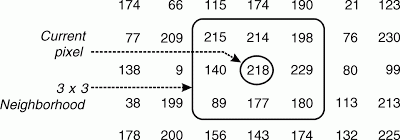The pixels surrounding a given pixel constitute its neighborhood, which can be interpreted as a smaller matrix containing (and usually centered around) the reference pixel. Most neighborhoods used in image processing algorithms are small square arrays with an odd number of pixels, for example, the 3 × 3 neighborhood shown below.
In the context of image topology, neighborhood takes a slightly different meaning. It is common to refer to the 4-neighborhood of a pixel as the set of pixels situated above, below, to the right, and to the left of the reference pixel (p), whereas the set of all of p's immediate neighbors is referred to as its 8-neighborhood. The pixels that belong to the 8-neighborhood, but not to the 4-neighborhood, make up the diagonal neighborhood of p (below).
Concept of neighborhood of pixel p (from an image topology perspective): (a) 4-neighborhood; (b) diagonal neighborhood; (c) 8-neighborhood.
From Practical Image and Video Processing Using MATLAB® by Oge Marques.
This blog is no longer active and is maintained for archival purposes. It served as a resource and platform for sharing insights into forensic multimedia and digital forensics. Whilst the content remains accessible for historical reference, please note that methods, tools, and perspectives may have evolved since publication. For my current thoughts, writings, and projects, visit AutSide.Substack.com. Thank you for visiting and exploring this archive.
Featured Post
Welcome to the Forensic Multimedia Analysis blog (formerly the Forensic Photoshop blog). With the latest developments in the analysis of m...


No comments:
Post a Comment